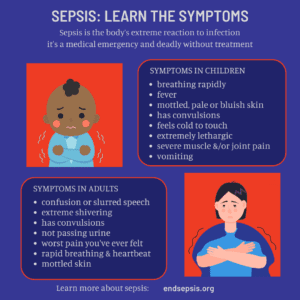
Pediatric Sepsis Week (April 20–26, 2025) is dedicated to recognizing the children who develop sepsis each year, honoring those who have passed away, and educating parents, caregivers, healthcare professionals, and the public about this life-threatening condition. Our goal remains clear: raise awareness, promote early recognition, and help prevent avoidable tragedies.
The Numbers Are Still Staggering
Each year in the United States, more than 75,000 children develop severe sepsis—and 7,000 of them will die. That’s more than the number of children who die from cancer. Yet, unlike cancer, sepsis remains widely under recognized by the general public.
Sepsis is the body’s overwhelming and life-threatening response to infection. When it occurs, the body turns on its own tissues and organs—leading to tissue damage, organ failure, and death if not treated quickly.
What Can We Do to Fight Pediatric Sepsis?
Here are a few steps every parent, caregiver, healthcare worker, and advocate can take:
1. Learn the signs of sepsis in children
Children with sepsis can decline rapidly—even within hours. Signs include:
- Fever or abnormally low temperature (especially in infants)
- Fast breathing or a racing heartbeat
- Vomiting, sleepiness, irritability, or difficulty waking
- Skin that appears pale, bluish, or mottled
- A rash that doesn’t fade when pressed
- Seizures or convulsions
- Severe muscle or joint pain
- In children under 5: no interest in feeding, vomiting, or not passing urine for 12+ hours
When something doesn’t feel right—trust your instincts. Ask, “Could it be sepsis?”
2. Support life-saving protocols
New York’s landmark sepsis protocols, known as Rory’s Regulations, have saved over 16,000 lives between 2015 and 2019. Pediatric-specific regulations, also introduced in 2013, led to a 40% reduction in pediatric sepsis deaths in the first two years alone. That’s over 5,000 children saved in just 23 months.
These protocols work. Now we need them nationwide.
3. Ask your school to adopt our Sepsis for Schools toolkit
It only takes a moment to make the request—and it could save a life. Our free, ready-to-use materials help schools educate staff, students, and parents about sepsis and its warning signs. Just follow the steps here to get started.
4. Read sepsis stories or share your sepsis story
Hearing from families affected by sepsis brings urgency and empathy to an often-overlooked condition. Stories can help others recognize the signs, advocate for better care, and feel less alone.
5. Use and share our free resources
Download our toolkits, videos, symptom guides, and social media assets to spread the word this week—and all year long.


